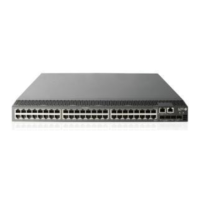78
Managing the file system
This chapter introduces the storage medium naming rules and file name formats, and describes how to
manage the device's file system, including the storage media, directories, and files.
Storage medium naming rules
If a storage medium is the only storage medium of its type on the device, it is named by its type. For
example, if the device has only one Flash, the name of the Flash is flash.
File name formats
When you specify a file, enter the file name in one of the formats shown in Table 18.
Table 18 File name formats
Format Descri
tion Len
th
Exam
le
file-name
Specifies a file in the current
working directory.
1 to 91
characters
a.cfg indicates a file named a.cfg
in the current working directory.
This working directory might be on
the master device or a subordinate
device.
path/file-name
Specifies a file in a specific folder
in the current working directory.
The path argument represents the
path to the file. If the file is in a
single-level folder, specify the
folder name for the argument. If the
file is in a nested folder, separate
each folder name by a forward
slash (/).
1 to 135
characters
test/a.cfg indicates a file named
a.cfg in the test folder in the current
working directory.
drive:/[path]/file-
name
Specifies a file in a specific storage
medium on the device.
The drive argument represents the
storage medium name.
The storage medium on the master
is typically flash.
The storage medium on a
subordinate device is typically
slotX#flash, where X represents the
member ID of the subordinate
device, for example, slot2#flash.
To view the correspondence
between a device and its member
ID, use the display irf command.
1 to 135
characters
flash:/test/a.cfg indicates a file
named a.cfg in the test folder in the
root directory of the Flash memory
on the master.
To access the file a.cfg in the root
directory of the Flash on the
subordinate device with member
ID 2, enter slot2#flash:/a.cfg for
the file name.

